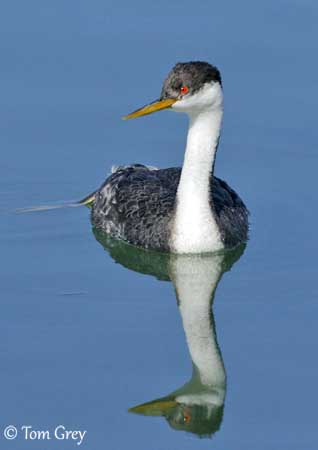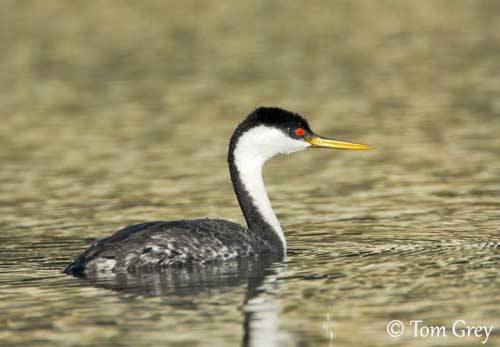
Fr: Grèbe elegant
All : Renntaucher
Esp : Achichilique Común
Ital: Svasso cigno
Nd: Zwanenhalsfuut
Sd: Svartbrynad svandopping
Photographer:
Tom Grey
Tom Grey's Bird Pictures
Text by Nicole Bouglouan
Sources:
HANDBOOK OF THE BIRDS OF THE WORLD vol 1 by Josep del Hoyo-Andrew Elliot-Jordi Sargatal - Lynx Edicions - ISBN: 8487334105
A GUIDE TO THE BIRDS OF MEXICO AND NORTHERN CENTRAL AMERICA by Steve N. G. Howell, Sophie Webb - Oxford University Press - ISBN: 0198540124
FIELD GUIDE TO THE BIRDS OF NORTH AMERICA - National Geographic Society - ISBN: 0792274512
L’ENCYCLOPEDIE MONDIALE DES OISEAUX - Dr Christopher M. Perrins - BORDAS - ISBN: 2040185607
BirdLife International (BirdLife International)
Animal Diversity Web (University of Michigan Museum of Zoology)
All About Birds (Cornell Lab of Ornithology)
Bird Web (Seattle Audubon Society)
What Bird-The ultimate Bird Guide (Mitchell Waite)
Western Grebe
Aechmophorus occidentalis
Podicipediforme Order – Podicipedidae Family
INTRODUCTION:
This large grebe is well known for its spectacular courtship displays, and especially the amazing “rushing-ceremony” during which the birds rush wildly across the water, side by side, with their bodies out of water and their necks gracefully curved forwards.
DESCRIPTION OF THE BIRD:
Biometrics:
Length: 51-74 cm
Weight: 550-1225 g
The Western Grebe adult has dark grey to blackish upperparts. Sides and flanks are paler grey. The underparts are white.
The tail is very short. Secondaries and bases of primaries are pale grey to white, often conspicuous in flight.
The black cap (through eye-level) and hindneck contrast strongly with the white face, neck sides and foreneck.
In breeding plumage, lores and eye area are black and the contrast is very strong.
In winter plumage, these areas are duller and less uniform. Crown and hindneck are duller too.
The bill is long and narrow, yellow-green with whitish culmen and edges. The eyes are bright red. Legs and feet are grey. Each toe has loose fleshy membrane which stretches under the water pressure when the bird is swimming.
Both sexes are similar.
The juvenile is greyer than the non-breeding adult, with more diffuse contrast. Its black bill becomes yellow by 80 days after hatching. The eyes are pale brown.

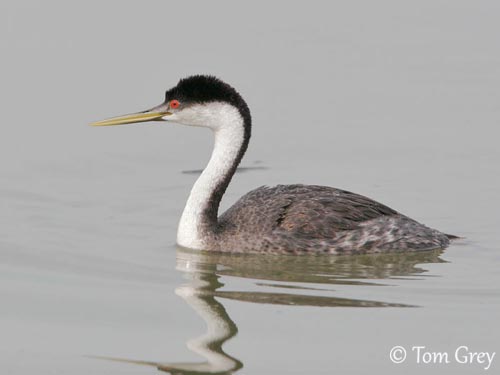
SUBSPECIES AND RANGE:
The Western Grebe has two subspecies which differ only in size.
A.o. occidentalis (here described and displayed) is found in SW and SC Canada and W and NC USA. It winters along the Pacific coast, southwards to Baja California.
A.o. ephemeralis occurs in CW and SC Mexico.
HABITAT:
During the breeding season, the Western Grebe frequents freshwater lakes, brackish marshes, reservoir and ponds, and usually areas with large stretches of open water with surrounding reedy vegetation.
In winter, it is often found in brackish and salt waters, including at sea along the coasts. It is visible in coastal bays and estuaries, and sometimes on inland freshwater sites.
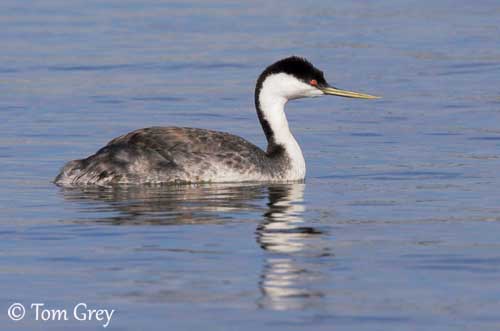
CALLS AND SONGS: SOUNDS BY XENO-CANTO
The Western Grebe utters loud-two-notes “crick-kreek”, also scratchy notes including a 2-3 syllable mate-advertising call “kree-kree” or “kree-kree-kreet”, and a high-pitched “h-weep h-weep…”
The advertising call is usually given by individuals when they are alone. This sound is important during pair-formation, and used as contact with mate or chicks. The solitary bird ceases calling once visual contact is restored.
Each individual has its own call-frequence pattern, a double-noted call in this species.
They are usually silent outside the breeding season.
BEHAVIOUR IN THE WILD:
The Western Grebe feeds mainly on both freshwater and marine fish, and it may take sometimes fairly large fish of up to 20 centimetres long. Aquatic insects, molluscs, crustaceans, marine worms and some amphibians are also included in its diet.
It fishes mainly by diving during about 30 seconds. Rapid bursts of diving are interspersed with long periods at surface where the bird probably feeds on fish’s schools. It uses its strong bill as a rapid spear thrust for hunting.
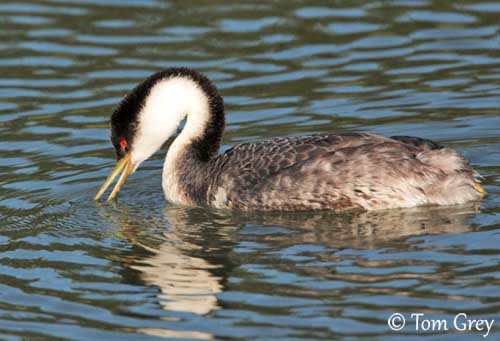
The Western Grebe is one of the two most piscivorous species with the Great Crested Grebe. Both have elongated body, slender neck and long thin bill.
During the breeding season, the Western Grebe performs amazing series of ritual displays, often more elaborate than in other species. This behaviour happens entirely in the water.
After several advertising calls, typical displays such as “Head-shaking Ceremony” occur. This one is an introduction to others, more elaborate.
Both birds are floating with the neck erect and facing each other. They shake their heads, quickly up and down and slowly side to side. They are silent.
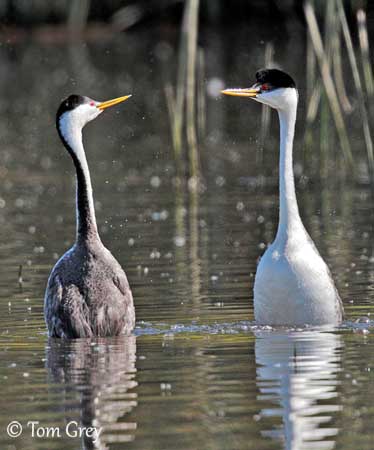
Another display, the “Weed ceremony” is used once the pair is well established. Both mates swim away from each other and submerge slowly. Then, they reappear, each with weeds in the bill. They move towards each other and suddenly, they rise up vertically, breast to breast, rocking quickly their heads from side to side, and rubbing each other with the weeds.
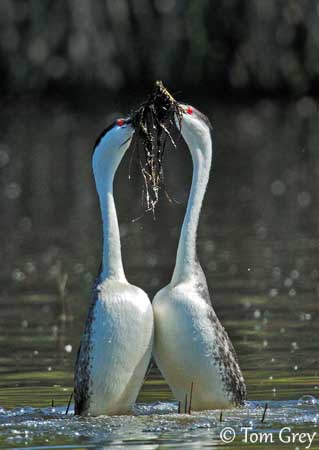
But the most spectacular display is the “Rushing Ceremony”. This display can be performed by two males, a male and a female, or several males and one female. Male and female rise up their bodies and rush wildly across the water. Their necks are gracefully curved forwards, and after 20-30 metres, both dive underwater simultaneously. This display is accompanied by raucous calls and loud splashes.
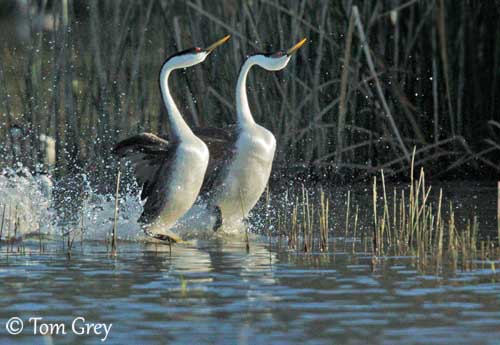
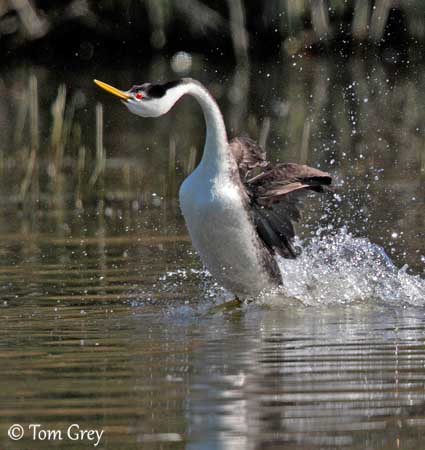
The copulation takes place on platforms constructed in shallow water, and is often accompanied by calls. Then, both mates usually “head-shake” together, one in the water and the other on the platform. They are monogamous.
As colonial nester, aggression and defence behaviour are simplified and usually, they only defend a small area around the nest-site.
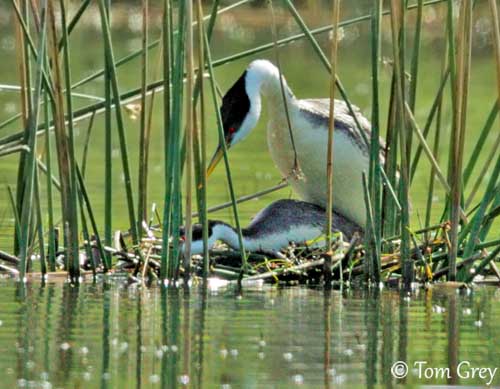
The Western Grebe is migratory and winters down Pacific coast. They start to move in September towards saltwater locations. They migrate by night over land, and partially by day along the coast where they often swim.
The Mexican populations appear fairly sedentary, with only local movements according to the season.
Like many grebes, the Western Grebe flies little and is more often seen in its aquatic environment than in the air. However, this species is able to migrate and to fly. It needs to run along the water surface while beating quickly its wings in order to take off. It has to keep beating the wings quickly during the flight too.
It can fly fast and over long distances during the migrations, performing direct flight and rapid wingbeats.
The Western Grebes often form major concentrations during migrations and in winter.
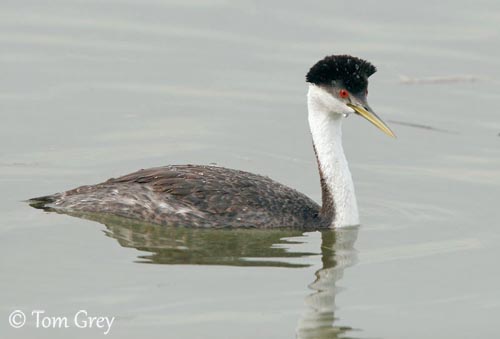
REPRODUCTION OF THIS SPECIES:
The laying occurs between May and July in USA and between May and October in Mexico.
The Western Grebe breeds sometimes in large colonies of hundreds or thousands of nests, and sometimes mixed with Clark Grebe (Aechmophorus clarkii). But it may occasionally breed solitary too.
Both sexes build a floating nest, a fairly solid mound of plant matter, floating or resting on the bottom. The nest is usually anchored to the emergent vegetation in shallow water in marshes.
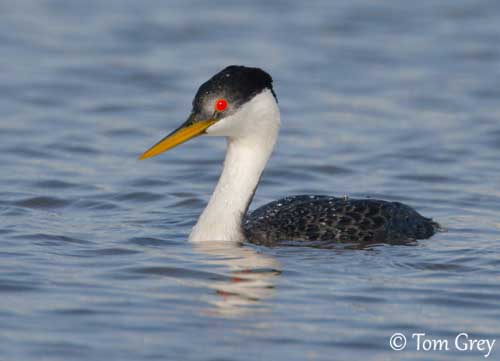
The female lays 3-4 pale blue eggs. But sometimes, several females may lay their eggs in the same nest within a colony. Both parents incubate during 21-28 days.
The chicks are precocial and leave the nest almost immediately after hatching. They are covered in smoky-grey down, whitish on head and underparts. They can often be seen riding on parent’s backs. They fledge about 70 days after hatching.
This species produces a single brood per season.
PROTECTION / THREATS / STATUS:
The Western Grebe is threatened by oil spills and insecticides accumulated in their food, involving reduced breeding success. Another threat is the reduction of the habitat, with increasing human developments.
However, populations are currently large and stable, and this species is not globally threatened.
